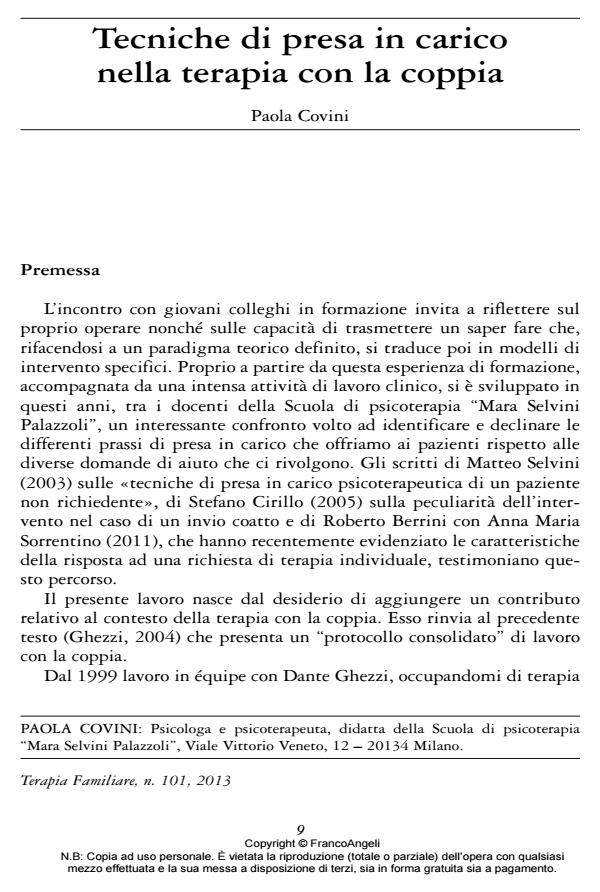Tecniche di presa in carico nella terapia con la coppia
Journal title TERAPIA FAMILIARE
Author/s Paola Covini
Publishing Year 2013 Issue 2013/101 Language Italian
Pages 28 P. 9-36 File size 140 KB
DOI 10.3280/TF2013-101002
DOI is like a bar code for intellectual property: to have more infomation
click here
Below, you can see the article first page
If you want to buy this article in PDF format, you can do it, following the instructions to buy download credits

FrancoAngeli is member of Publishers International Linking Association, Inc (PILA), a not-for-profit association which run the CrossRef service enabling links to and from online scholarly content.
The couples work is promoted by the respect of some steps at the stage of initial consultation which mark listening to the demand, sharing gathered information, convocation, therapeutic contract. What we initially have to treat is often each partner‘s individual sufferance, the grief of his/her betrayed expectations and the hope his/her position will be acknowledged as "the right one". We activate to deal with the specific relationship they have built together along the years where each one is now suffering. The attention focused on the building of the context, based on the creation of a "safe" space for listening and equal proximity to each partner, becomes necessary to build a shared therapeutic demand which can be answered by the team.
Keywords: Couple therapy; engagement techniques; therapeutic demand; therapeutic contract; context; safe space
- Andolfi M. (a cura di) (1999). La crisi della coppia. Una prospettiva sistemicorelazionale. Milano: Raffaello Cortina
- Berrini R., Cambiaso G. (2001). Illusioni di coppia. Milano: FrancoAngeli
- Berrini R., Sorrentino A. (2008). I colloqui di presa in carico nella terapia individuale. Terapia Familiare, 95: 5-17. DOI: 10.3280/TF2011-095002
- Beavers W.R. (1986). Il matrimonio riuscito. Un approccio sistemico alla terapia della coppia. Roma: Astrolabio
- Bowen M. (1980). Dalla famiglia all’individuo. Roma: Astrolabio
- Caillè P. (1991). Un et un font trois. Paris: Esf
- Cigoli V. (2001). Incontro alla coppia. Lo sguardo tenero e la partecipazione drammatica. Milano: McGraw-Hill.
- Cirillo S. (2005). Cattivi genitori. Milano: Raffaello Cortina
- Di Blasio P., Fischer J.M., Prata G. (1986). La cartella telefonica: pietra angolare della prima intervista con la famiglia. Terapia Familiare, 22: 5-17
- Doherty W.J. (1999). Scrutare nell’anima. Responsabilità morale e psicoterapia. Milano: Raffaello Cortina
- Ghezzi D. (2004). Terapia con le coppie, un protocollo consolidato. Terapia Familiare, 74: 11-41. DOI: 10.1400/68143
- Ghezzi D., Lerma M. (1994). Il terapeuta terzo in terapia di coppia. Connessioni 8, dicembre
- Ghezzi D., Lerma M., Martino C. (1984). Le prime fasi della terapia familiare: un’équipe rivede le proprie strategie. Terapia Familiare, 15: 5-22
- Mazzei D. (2002). La mediazione familiare. Il modello simbolico trigenerazionale. Milano: Raffaello Cortina
- Mc Goldrick M., Anderson C., Walsh F. (a cura di) (1989). Women in families. A framework for family therapy. New York: Norton
- Real del Sarte O. (2010). Le couple coopère-t-il? Perspective piagétienne sut l’épistémologie et la pratique systémique, Toulose: Erès.
- Selvini M. (2003). Tecniche di presa in carico psicoterapeutica di un paziente non richiedente. Terapia Familiare, 73: 5-33. DOI: 10.1400/69273
- Scabini E., Cigoli V. (2000). Il famigliare. Milano: Raffaello Cortina.
- Walsh F. (2008). La resilienza familiare. Milano: Raffaello Cortina
- Quando c'è un terzo nella coppia. Strategie cliniche Dante Ghezzi, Paola Covini, in TERAPIA FAMILIARE 127/2022 pp.31
DOI: 10.3280/TF2021-127003 - I figli nella terapia con le coppie. Lavorare con le coppie e "averli ben in testa" Paola Covini, in TERAPIA FAMILIARE 130/2023 pp.5
DOI: 10.3280/TF2022-130001
Paola Covini, Tecniche di presa in carico nella terapia con la coppia in "TERAPIA FAMILIARE" 101/2013, pp 9-36, DOI: 10.3280/TF2013-101002